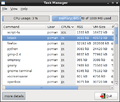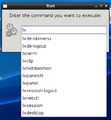LXDE
 | |
 Default LXDE desktop | |
| Original author(s) | Hong Jen Yee ("PCMan") |
|---|---|
| Developer(s) | The LXDE Team |
| Initial release | 2006 |
| Final release | 0.10.1[1] |
| Repository | |
| Written in | C (GTK 2, GTK 3) |
| Operating system | Unix-like |
| Platform | Linux, BSD |
| Type | Desktop environment |
| License | GPL, LGPL |
| Website | lxde |
LXDE (abbreviation for Lightweight X11 Desktop Environment) was a free desktop environment with comparatively low resource requirements. This makes it especially suitable for use on older or resource-constrained personal computers[2] such as netbooks or system on a chip computers.
Overview
[edit]LXDE was written in the C programming language, using the GTK 2 toolkit, and runs on Unix and other POSIX-compliant platforms, such as Linux and BSDs. The LXDE project aims to provide a fast and energy-efficient desktop environment.[3][4]
LXDE uses rolling releases for its individual components (or for groups of components with coupled dependencies).[5] The default window manager used is Openbox, but one can configure a third-party window manager for use with LXDE, such as Fluxbox, IceWM or Xfwm.[6] LXDE includes GPL-licensed code as well as LGPL-licensed code.[3]
History
[edit]The project was started in 2006 by Taiwanese programmer Hong Jen Yee (Chinese: 洪任諭; pinyin: Hóng Rènyù), also known as PCMan, when he published PCManFM, a new file manager and the first module of LXDE.
In 2010, tests suggested that LXDE 0.5 had the lowest memory-usage of the four most-popular desktop environments of the time (the others being GNOME 2.29, KDE Plasma Desktop 4.4, and Xfce 4.6),[7] and that it consumed less energy,[8] which suggested mobile computers with Linux distributions running LXDE 0.5 drained their batteries at a slower pace than those with other desktop environments.
Qt port
[edit]Dissatisfied with GTK 3,[9] Hong Jen Yee experimented with Qt in early 2013[10] and released the first version of a Qt-based PCManFM on 26 March 2013.[9]
On 3 July 2013 Hong announced a Qt port of the full LXDE suite,[11] and on 21 July Razor-qt and LXDE announced that they would merge the two projects.[12][13][14] This merger meant that the GTK and the Qt versions would coexist for some time but, eventually, all original team efforts focused on the Qt port, LXQt.[15]
Current development
[edit]Despite the original team moving to LXQt development, some other developers continued to maintain LXDE on GitHub and, as of March 2021, there are fresh commits to keep updated the GTK 2 version. As of July 2019 LXTerminal release is based on GTK 3 to avoid dependencies on the old VTE lib.[16][17]
GTK 3 port
[edit]As of May 2020, there is an experimental GTK 3 port developed by the Arch Linux community.[18] GTK 3 versions have already been developed for the following components: LXAppearance, LXAppearance-ObConf, LXDE-common, LXDE-icon-theme, LXDM, LXhotkey, LXInput, LXLauncher, LXPanel, LXRandR, LXSession, LXTask, LXTerminal, Openbox, PCManFM.[19] One advantage of using GTK 3 is that GTK 3 programs run natively on Wayland. PCManFM is a popular file manager for use with tiling window managers and hence, having a Wayland-native PCManFM is useful for people that use Sway.[citation needed]
Availability
[edit]

Default desktop
Alternative desktop
- Arch Linux[23]
- Artix Linux[24][25]
- Debian[26]
- Devuan[27]
- Fedora[28]
- Raspberry Pi OS[29][30] (Raspberry Pi 4 and 5 use the Wayfire Wayland compositor by default. Older models use a heavily modified fork of LXDE called PIXEL, but they will also be switched to Wayfire in the future)
Former default desktop
- Lubuntu (replaced by LXQt in 2018)[31]
- Artix Linux[24][25] (now available as an alternative desktop)
- Peppermint OS (replaced by Xfce in 2022)[32]
Software components of LXDE
[edit]Unlike other major desktop environments such as GNOME, the components of LXDE have few dependencies and are not tightly integrated.[33] Instead, they can be installed independently of each other or LXDE itself.[34]
| Components | Descriptions | Notes |
|---|---|---|
| PCMan File Manager | File manager and Desktop metaphor provider | |
| LXInput | Mouse and keyboard configuration tool | |
| LXLauncher | Easy-mode application launcher | |
| LXPanel | Desktop panel | |
| LXSession | X session manager | |
| LXAppearance | GTK theme switcher | |
| GPicView | Image viewer | |
| LXMusic | A frontend for the XMMS2 audio player | |
| LXTerminal | Terminal emulator | LXTerminal can be configured to hide the menu bar and the scrolling bar |
| LXTask | Task manager | |
| LXRandR | A GUI to RandR | |
| LXDM | X display manager | |
| LXNM | Lightweight network connection helper daemon. Supports wireless connections (Linux only). | Discontinued |
| Leafpad | Text editor | Not developed by the LXDE project |
| Openbox (Fluxbox, IceWM and Xfwm are also supported) | Window manager | Not developed by the LXDE project |
| ObConf | A GUI tool to configure Openbox | Not developed by the LXDE project |
| Xarchiver | File archiver | Not developed by the LXDE project |
-
GPicView
-
LXAppearance
-
LXPanel
-
LXPanel Preferences
-
LXTask
-
PCManFM
-
Autocompletion of Panel tasks
See also
[edit]- LXQt – A lightweight desktop environment and spiritual successor to LXDE
- Xfce – Another lightweight desktop environment built using GTK
- Comparison of X Window System desktop environments
References
[edit]- ^ "LXPanel 0.10.1 released". 25 February 2021. Retrieved 3 June 2023.
- ^ Christopher Smart (9 September 2009). "Lubuntu: Floats Like a Butterfly, Stings Like a Bee". Linux Magazine. Archived from the original on 11 September 2009. Retrieved 10 September 2009.
{{cite web}}: CS1 maint: unfit URL (link) - ^ a b LXDE Team. "LXDE". Retrieved 26 October 2008.
- ^ LXDE Team. "About LXDE". Archived from the original on 14 October 2008. Retrieved 1 November 2008.
- ^ "Description of current release process". Article.gmane.org. Archived from the original on 13 October 2016. Retrieved 19 May 2014.
- ^ "LXDE". Archived from the original on 20 January 2016. Retrieved 12 January 2016.
- ^ Larabel, Michael. "Power & Memory Usage of GNOME, KDE, LXDE & Xfce". Phoronix. Archived from the original on 3 September 2018. Retrieved 30 July 2011.
- ^ Larabel, Michael. "Power & Memory Usage of GNOME, KDE, LXDE & Xfce (page 2)". Phoronix. Retrieved 30 July 2011.
- ^ a b "PCManFM Qt 0.1.0 released". LXDE Blog. 27 March 2013. Retrieved 4 May 2013.
- ^ "PCManFM file manager is ported to Qt?". LXDE Blog. 19 February 2013. Retrieved 4 May 2013.
- ^ "LXDE-Qt Preview". LXDE. 3 July 2013. Retrieved 27 March 2014.
- ^ brother (22 July 2013). ""The future of Razor and LXDE-Qt"". Blog.lxde.org. Retrieved 19 May 2014.
- ^ "The future of Razor and LXDE-Qt at Razor-qt Google group". Retrieved 19 May 2014.
- ^ ""The future of Razor and LXDE-Qt" at the LXDE-list archive". Sourceforge.net. 20 July 2013. Retrieved 19 May 2014.
- ^ "The Future of Razor and LXDE-Qt". Blog.lxde.org. 22 July 2013. Retrieved 19 May 2014.
- ^ "LXTerminal sources news". github.com/lxde/lxterminal.
- ^ "Debian -- Details of package lxterminal in buster". packages.debian.org.
- ^ "Arch Linux LXDE". wiki.archlinux.org.
- ^ Judd Vinet, Aaron Griffin and Levente Polyák (2021). "Group Details – lxde-gtk3 (x86_64)". archlinux.org. Archived from the original on 14 August 2021. Retrieved 14 August 2021.
- ^ "KNOPPIX – Live Linux Filesystem on CD". knopper.net.
- ^ "What is it? < The LXLE Desktop". lxle.net. Retrieved 20 October 2016.
- ^ "Trisquel Mini". 16 November 2021.
- ^ "Arch Linux – Package Search". archlinux.org.
- ^ a b "Early Artix Linux ISOs". Retrieved 8 April 2020.
- ^ a b "Artix Linux minimal ISOs". Retrieved 8 April 2020.
- ^ "13.3. Graphical Desktops". debian.org.
- ^ "Devuan installation documentation". devuan.org.
- ^ Brodkin, Jon (15 January 2013). "How to install the MATE and Cinnamon desktops on Fedora 18". Ars Technica. Retrieved 15 January 2013.
- ^ "Introducing PIXEL". 28 September 2016.
- ^ "Bookworm — the new version of Raspberry Pi OS". 11 October 2023.
- ^ "This Week in Lubuntu Development #5 – Lubuntu". lubuntu.me. 14 May 2018. Retrieved 19 May 2018.
- ^ "Peppermint Release Notes". 2 November 2023.
- ^ Łukasz Bigo. "LXDE – lekka alternatywa do GNOME". Archived from the original on 2 February 2009. Retrieved 8 August 2008.
- ^ "About LXDE". Lxde.sourceforge.net. Retrieved 19 May 2014.
External links
[edit]







